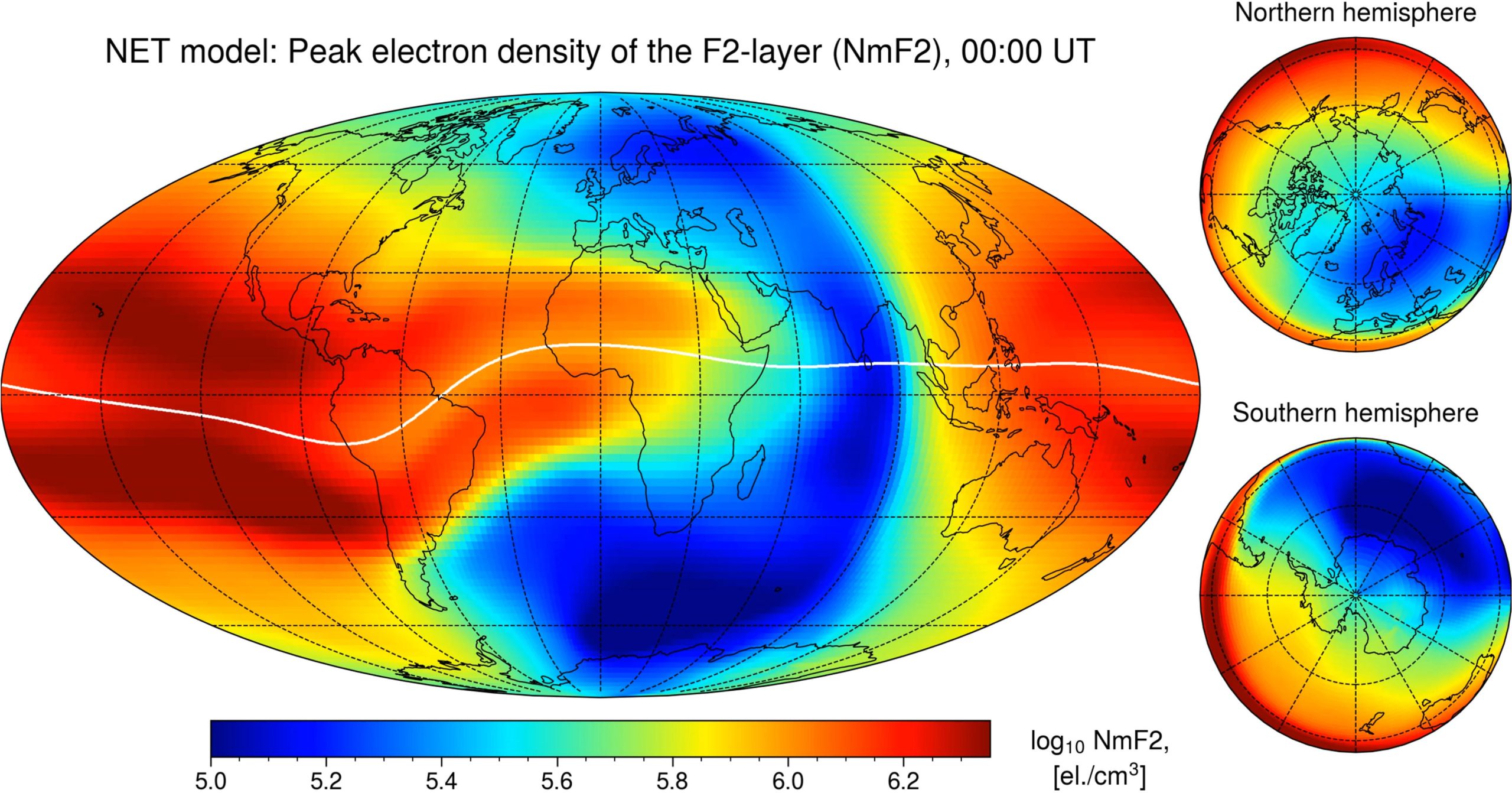Angetrieben von neuronalen Netzwerken – Wissenschaftler entwickeln ein genaueres Modell der Ionosphäre der Erde


Die Ionosphäre ist eine Schicht der oberen Erdatmosphäre, die durch Sonnenstrahlung ionisiert wird und eine wichtige Rolle bei Kommunikation und Navigation spielt.
Neuronale Netze haben unsere Fähigkeit zur Rekonstruktion der Atmosphärenschicht der Erde erheblich verbessert, sodass genauere Ergebnisse erzielt werden können. Dies hat unter anderem große Auswirkungen auf die Satellitennavigation.
Die Ionosphäre, eine Region des geografischen Raums zwischen 60 und 1.000 Kilometer über der Erde, stört aufgrund ihrer elektrisch geladenen Teilchen die Übertragung von Funksignalen von globalen Navigationssatellitensystemen (GNSS). Diese Überschneidung stellt Herausforderungen an die erhöhte Präzision, die diese Systeme sowohl in der Forschung als auch in praktischen Anwendungen benötigen, wie zum Beispiel autonomes Fahren oder die präzise Bestimmung der Umlaufbahn eines Satelliten.
Um Verzögerungen in der Ionosphäre zu kompensieren, die eine Hauptfehlerquelle bei GNSS-Anwendungen darstellen, können schwankende dynamische Ladungsverteilung und ionosphärische Modelle verwendet werden. Die Forscher Artem Smirnov und Yuri Shprits vom deutschen GeoForschungsZentrum GFZ stellten ein neues Modell der Ionosphäre vor. Das Modell, das auf neuronalen Netzen und 19 Jahren Satellitenmessdaten beruht, wird in der Fachzeitschrift veröffentlicht
Electron density of the Ionosphere around the Earth for a certain point of time: high values in red, low values in blue. The white line marks the geomagnetic equator. Credit: Smirnov et al. (2023) – Scientific Reports
Background: Importance and complexity of the ionosphere
The Earth’s ionosphere is the region of the upper atmosphere that extends from about 60 to 1000 kilometers in altitude. Here, charged particles such as electrons and positive ions dominate, caused by the radiation activity of the Sun – hence the name. The ionosphere is important for many scientific and industrial applications because the charged particles influence the propagation of electromagnetic waves such as radio signals.
The so-called ionospheric propagation delay of radio signals is one of the most important sources of interference for satellite navigation. This is proportional to the electron density in the space traversed. Therefore, a good knowledge of the electron density can help in correcting the signals. In particular, the upper region of the ionosphere, above 600 kilometers, is of interest, since 80 percent of the electrons are gathered in this so-called topside ionosphere.
The problem is that the electron density varies greatly – depending on the longitude and latitude above the Earth, the time of day and year, and solar activity. This makes it difficult to reconstruct and predict them, the basis for correcting radio signals, for example.
Animation der sich ändernden Elektronendichte der Ionosphäre um die Erde über drei volle Tage: hohe Werte in Rot, niedrige Werte in Blau. Die weiße Linie repräsentiert den geomagnetischen Äquator. Bildnachweis: Smirnoff et al. (2023) – Wissenschaftliche Berichte
Vorgängermodelle
Zur Modellierung der Elektronendichte in der Ionosphäre gibt es verschiedene Methoden, unter anderem das seit 2014 anerkannte International Reference Ionosphere Model IRI. Es handelt sich um ein empirisches Modell, das auf Basis der statistischen Analyse einen Zusammenhang zwischen Eingangs- und Ausgangsgrößen herstellt Beobachtungen. Allerdings weist es in einer wichtigen Region der oberen Ionosphäre aufgrund der begrenzten Abdeckung von zuvor in dieser Region gesammelten Beobachtungen noch Schwächen auf.
In letzter Zeit sind jedoch große Datenmengen für diese Region verfügbar geworden. Daher bieten sich Ansätze des maschinellen Lernens (ML) an, um daraus Regelmäßigkeiten abzuleiten, insbesondere für komplexe nichtlineare Zusammenhänge.
Ein neuer Ansatz mit maschinellem Lernen und neuronalen Netzen
Ein Team des Deutschen GeoForschungsZentrums GFZ ist um Artem Smirnov, Ph.D. Student und Erstautor der Studie, Juri Shpritz, Leiter der Abteilung „Weltraumphysik und Weltraumwetter“ und Professor an der Universität Potsdam, hat einen neuen experimentellen Ansatz auf Basis von ML durchgeführt. Dazu nutzten sie Daten von 19 Satellitenmissionen, insbesondere CHAMP, GRACE und GRACE-FO, die maßgeblich vom GFZ und COSMIC betrieben wurden und werden. Die Satelliten haben unter anderem die Elektronendichte in verschiedenen Höhenbereichen der Ionosphäre und zu verschiedenen Jahres- und Ortszeiten sowie Sonnenzyklen gemessen.
Mit Hilfe von Neural Networks haben die Forscher ein Modell der Elektronendichte in der oberen Ionosphäre entwickelt, das sie NET-Modell nennen. Sie verwendeten ein sogenanntes MLP-Verfahren (Multi-Layer Perceptrons), das Netzwerkgewichte iterativ lernt, um Datenverteilungen mit einem sehr hohen Grad an Genauigkeit zu reproduzieren.[{“ attribute=““>accuracy.
The researchers tested the model with independent measurements from three other satellite missions.
Evaluation of the new model
“Our model is in remarkable agreement with the measurements: It can reconstruct the electron density very well in all height ranges of the topside ionosphere, all around the Globe, at all times of the year and day, and at different levels of solar activity, and it significantly exceeds the International Reference Ionosphere Model IRI in accuracy. Moreover, it covers space continuously,” first author Artem Smirnov sums up.
Yuri Shprits adds: “This study represents a paradigm shift in ionospheric research because it shows that ionospheric densities can be reconstructed with very high accuracy. The NET model reproduces the effects of numerous physical processes that govern the dynamics of the topside ionosphere and can have broad applications in ionospheric research.”
Possible applications in ionosphere research
The researchers see possible applications, for instance, in wave propagation studies, for calibrating new electron density data sets with often unknown baseline offsets, for tomographic reconstructions in the form of a background model, as well as to analyze specific space weather events and perform long-term ionospheric reconstructions. Furthermore, the developed model can be connected to plasmaspheric altitudes and thus can become a novel topside option for the IRI.
The developed framework allows the seamless incorporation of new data and new data sources. The retraining of the model can be done on a standard PC and can be performed on a regular basis. Overall, the NET model represents a significant improvement over traditional methods and highlights the potential of neural network-based models to provide a more accurate representation of the ionosphere for communication and navigation systems that rely on GNSS.
Reference: “A novel neural network model of Earth’s topside ionosphere” by Artem Smirnov, Yuri Shprits, Fabricio Prol, Hermann Lühr, Max Berrendorf, Irina Zhelavskaya and Chao Xiong, 24 January 2023, Scientific Reports.
DOI: 10.1038/s41598-023-28034-z

Bierfan. TV-Wegbereiter. Alkoholiker. Allgemeiner Zombie-Evangelist. Total-Reiseleiter








